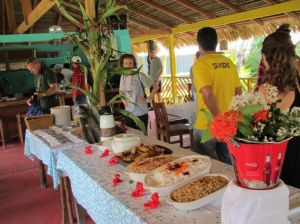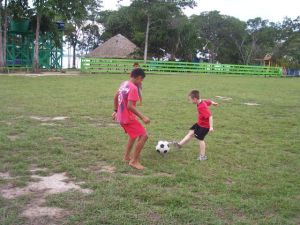Obrigada (thank you) is the one Portuguese word I used consistently (and pronounced correctly) throughout our 5 day stay in Manaus, Brazil. I’d like to thank Brazil for educating me and stretching my mind and heart in a way that a new destination hasn’t for a long time!
On our third morning Jason and I decided to walk the kids to a park we’d seen on an early morning run. About 30 minutes away on foot, the route goes by the Manaus market, a busy flurry of commerce wedged between downtown and the Rio Negra river. 
 Noisy trucks haul in the catches of the day and unload their freight directly at the undercover market, as well as fruit and other produce. The fish market itself is in a separate garage-type structure. Talk about a barrage on the olfactory senses: pungent fish, garbage, fuel, heat (yes, heat has a scent in Manaus), and the occasional whiff of sweet pineapple! I wanted to take more photos and explore the market but the aromas were too overpowering.
Noisy trucks haul in the catches of the day and unload their freight directly at the undercover market, as well as fruit and other produce. The fish market itself is in a separate garage-type structure. Talk about a barrage on the olfactory senses: pungent fish, garbage, fuel, heat (yes, heat has a scent in Manaus), and the occasional whiff of sweet pineapple! I wanted to take more photos and explore the market but the aromas were too overpowering.  We witnessed a lot of poverty on this walk, from homeless people resting on the sidewalk, to families living in dilapidated (maybe abandoned?) boats down below on the shore. Across a littered ravine loomed a favela, the type of ghetto we warned to steer clear of.
We witnessed a lot of poverty on this walk, from homeless people resting on the sidewalk, to families living in dilapidated (maybe abandoned?) boats down below on the shore. Across a littered ravine loomed a favela, the type of ghetto we warned to steer clear of.
The park is a strange modern oasis smack in the middle of the crumbling downtown core. We heard it was once a destitute apartment building that the government razed to develop this manicured setting. We strolled through precise landscaping, paved paths, and garden art, until we found what we were seeking: play equipment!  The only other people we saw were several uniformed park rangers, including one who informed me in Portuguese I wasn’t allowed to climb on the play equipment since I was an adult! Another S.A.S. family showed up later so the kids were happy to have a playmate.
The only other people we saw were several uniformed park rangers, including one who informed me in Portuguese I wasn’t allowed to climb on the play equipment since I was an adult! Another S.A.S. family showed up later so the kids were happy to have a playmate.
That afternoon was our last field trip, a Brazilian dance fusion workshop. We spent 2 1/2 hours at the Ritmo Quento Dance Academy learning dances like the Lambada and Samba The upbeat music and capable instructors immersed us in the rhythms for a fun and energizing afternoon! (My calves were sore for two days!) We learned how dance is such an integral part of Brazilian culture; people begin dancing when they are toddlers and love to dance whenever and wherever as an expression of their joy. Brazilians love life! In fact, I later heard from some college students who stumbled into a samba street dance (perhaps a “rehearsal” of sorts for carnivale?) and the dancers folded them into the dance all night like they were long-lost friends!

 Our final day in Manaus was a short one since our on-ship time was 3:00. On-board ship time is always two hours before we sail and oftentimes there’s a line to get back on, due to the ship’s security searching bags, etc. Our plan was to take a taxi to Bosque da Ciencia, which translates to the Forest of Science. Our taxi driver kindly offered to stay there and return us to the port when we were done (must have been a slow morning!) Again, it was surprising how much you can communicate with a language barrier!
Our final day in Manaus was a short one since our on-ship time was 3:00. On-board ship time is always two hours before we sail and oftentimes there’s a line to get back on, due to the ship’s security searching bags, etc. Our plan was to take a taxi to Bosque da Ciencia, which translates to the Forest of Science. Our taxi driver kindly offered to stay there and return us to the port when we were done (must have been a slow morning!) Again, it was surprising how much you can communicate with a language barrier!
The Forest of Science was essentially a small scale zoo in a wooded setting. The main animals featured were lots of turtles, eels, manatees, and alligators. There was a large, unenclosed pond where we tentatively searched for the alligators, only to see more enormous turtles and a baby caiman on the shore.
unenclosed pond where we tentatively searched for the alligators, only to see more enormous turtles and a baby caiman on the shore.  The Forest of Science typified much of what we observed in downtown Manaus: most exhibits were shabby with faded signs and old structures. In general, not a lot of maintenance. It didn’t matter – the place was shady and quiet and we had a blast looking at the exotic animals, especially the alligators. We found them tucked away in an unmarked corner, lounging safely behind tall chain-link fences. Their “pens” weren’t super big, so we enjoyed close up views of these giant reptiles.
The Forest of Science typified much of what we observed in downtown Manaus: most exhibits were shabby with faded signs and old structures. In general, not a lot of maintenance. It didn’t matter – the place was shady and quiet and we had a blast looking at the exotic animals, especially the alligators. We found them tucked away in an unmarked corner, lounging safely behind tall chain-link fences. Their “pens” weren’t super big, so we enjoyed close up views of these giant reptiles.

We had a few minutes to kill before it was time to meet the taxi driver. And we wanted to spend the remainder of our Real $ (ree-al) currency. The kids easily found a couple of souvenirs in the dinky gift shop! William chose a painted, wooden riverboat, and Vivian chose a berry-red beaded necklace; both were handmade. They are posing with their mementos in front of the manatees. 
We were all basking in the smoothness of the pleasant morning. By the 5th day, the edgy newness of the city had worn off and this was a great way to end our stay. Then things took a turn, as they often do in this life! As the taxi driver pulled up to the port terminal, Vivian realized she didn’t have her camera. Her Brand-New, Christmas-Present, Favorite-Toy-Ever Digital Camera.
We quickly made a plan: 1. Withdraw more currency. 2. Vivian and Jason took a new taxi back to the Forest of Science. 3. William and I headed back to the ship for lunch. 4. Sent prayers to St. Anthony, the saint from my Catholic upbringing who often helps us find lost objects. I was confident they would make it back before 3:00.
Almost 2 hours later Vivian and Jason delivered the dejection. No camera. Not surprising given the situation and the fact that petty crime is sky-high in Manaus. It was a depressing note to end on and a hard lesson for her to learn. But we all were safe, healthy, and together.
This visit to Brazil confirmed what I’d learned in books about the disparity between the rich and poor. Most of Manaus’s 1.7 million population we’d consider the working poor. There’s a very small middle class in Brazil (it’s even more pronounced in the north due to factors like education and health care) and the richest 10% control 60% of the wealth. Brazil has a 25% tax rate, but the government is fiscally corrupt.
Through my own American lens I found myself humbled throughout this experience. Not knowing Portuguese and confounded that so few Brazilians speak English reminded me of my limited experiences. Navigating the sweltering, dirty, crowded, city of Manaus made me thankful for my hometown in the cool and sparkling Pacific Northwest. The vastness of Amazonas and its rivers, the untamed beauty of the jungle, the simplicity of the villages….all of these were awe-inspiring.
What a wide world we inhabit. The magnitude of this voyage reveals itself layer by layer through each port.
















